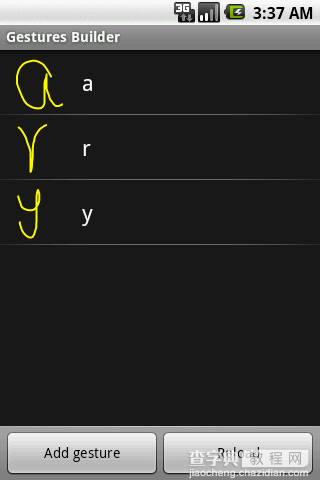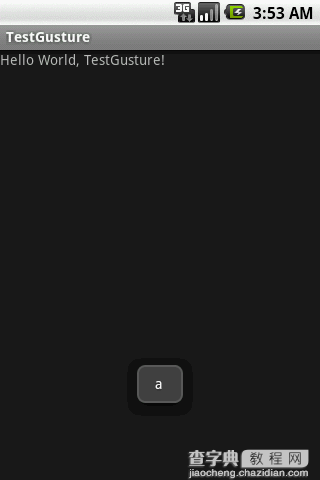本文实例分析了Android实现Gesture手势识别用法。分享给大家供大家参考。具体如下:
很高兴能在Android1.6的sdk看到手势识别这一功能,之前一直在想,如何在android中实现nds游戏那样用手势(准确点应该是笔势)来控制游戏角色?现在总算看到一点曙光了,不过手势要做到笔势那样随心所欲地控制游戏人物,还有很多细节问题需要处理。
在Android1.6的模拟器里面预装了一个叫Gestures Builder的程序,这个程序就是让你创建自己的手势的(Gestures Builder的源代码在sdk问samples里面有,有兴趣可以看看)。创建的手势将被保存到/sdcard/gestures里面,把这个文件复制到你的工程/res/raw下,你就可以在你的工程里面使用这些手势了。复制到/res/raw下的手势是只读的,也就是说你不能修改或增加手势了,如果想实现增改的话,可以直接加载sd卡里面的gestures文件。
在例子中,我创建了这样的手势:

第二步:在layout里面创建GestureOverlayView,这个透明的view就是让你在上面画手势用的,可以叠在其他View上面:
<"1.0" encoding="utf-8"?> <LinearLayout xmlns:android="http://schemas.android.com/apk/res/android" android:orientation="vertical" android:layout_width="fill_parent" android:layout_height="fill_parent" > <TextView android:layout_width="fill_parent" android:layout_height="wrap_content" android:text="@string/hello" /> <android.gesture.GestureOverlayView android:id="@+id/gestures" android:layout_width="fill_parent" android:layout_height="0dip" android:layout_weight="1.0" /> </LinearLayout>
第三步:载入Gesture:
mLibrary = GestureLibraries.fromRawResource(this, R.raw.gestures); if (!mLibrary.load()) { finish(); }
第四步:增加响应函数OnGesturePerformedListener:
GestureOverlayView gestures = (GestureOverlayView) findViewById(R.id.gestures); gestures.addOnGesturePerformedListener(this);
以上四步就可以实现简单的Gesture识别原型了:
程序运行结果如下,书写一个a字,程序识别出,然后toast一个a出来:

完整代码如下:
package com.ray.test; import java.util.ArrayList; import android.app.Activity; import android.gesture.Gesture; import android.gesture.GestureLibraries; import android.gesture.GestureLibrary; import android.gesture.GestureOverlayView; import android.gesture.Prediction; import android.gesture.GestureOverlayView.OnGesturePerformedListener; import android.os.Bundle; import android.widget.Toast; public class TestGesture extends Activity implements OnGesturePerformedListener{ GestureLibrary mLibrary; @Override public void onCreate(Bundle savedInstanceState) { super.onCreate(savedInstanceState); setContentView(R.layout.main); GestureOverlayView gestures = (GestureOverlayView) findViewById(R.id.gestures); gestures.addOnGesturePerformedListener(this); mLibrary = GestureLibraries.fromRawResource(this, R.raw.gestures); if (!mLibrary.load()) { finish(); } } @Override public void onGesturePerformed(GestureOverlayView overlay, Gesture gesture) { ArrayList predictions = mLibrary.recognize(gesture); // We want at least one prediction if (predictions.size() > 0) { Prediction prediction = (Prediction) predictions.get(0); // We want at least some confidence in the result if (prediction.score > 1.0) { // Show the spell Toast.makeText(this, prediction.name, Toast.LENGTH_SHORT).show(); } } } }
希望本文所述对大家Android程序设计有所帮助。
【Android实现Gesture手势识别用法分析】相关文章:
★ Android实现Activities之间进行数据传递的方法
